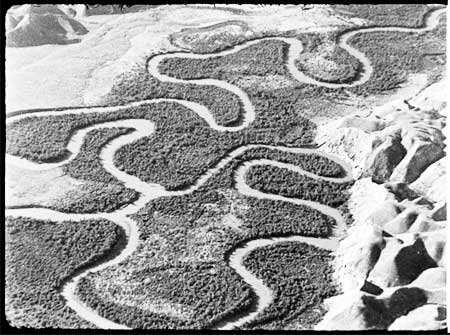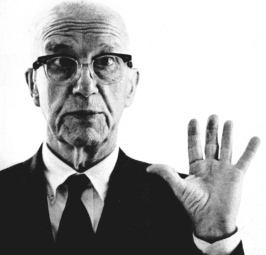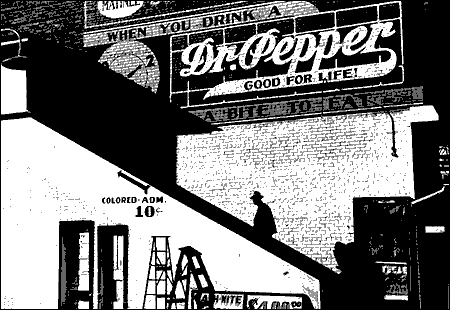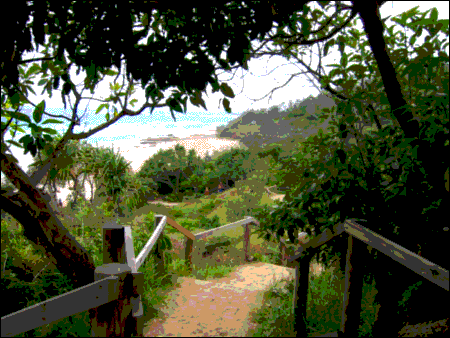Marking time in January 2003
An Act to Protect Motor Vehicles from Dangerous Pedestrians
From the annals of wrong thinking—an American politician has tried to solve a problem by introducing a bill:[Democrat Representative Christopher O’Neil] is sponsoring a bill to repeal Maine’s law that says a motorist must yield the right of way to a pedestrian who is crossing within a marked crosswalk.
The very title of his bill, “An Act to Protect Motor Vehicles From Dangerous Pedestrians,” has generated a round of chuckles and wisecracks in the State House among those who are convinced that O’Neil can’t be serious. But the Saco Democrat has news for them.
“It’s not a joke bill,” said O’Neil, who has no co-sponsors on the measure before the Transportation Committee.
O’Neil said it’s time for Maine to rethink a law that he believes has put too many people at risk of injury or death on the state’s streets, particularly in congested downtown shopping areas.
Rise up, you pedestrians, and Be Dangerous!
Hurley at the National Library
The National Library of Australia has digitised its fabulous collection of Frank Hurley negatives and made the images available on the web. Bravo!

Frank Hurley has been a hero for me, since I read Shackleton’s argonauts at the age of 12.
Fire at Mount Stromlo
The ABC website has a story about the tragic fires around Canberra. Four people dead, at least 368 houses destroyed, and the historic Mount Stromlo Observatory in ruins.
![Burnt out telescope [image from the ABC website]](images/burntStromlo.jpg)
Everything Bucky knew
Everything I know is a complete video, audio and text record of a Richard Buckminster Fuller talkathon:

During the last two weeks of January 1975 Buckminster Fuller gave an extraordinary series of lectures concerning his entire life’s work. These thinking out loud lectures span 42 hours and examine in depth all of Fuller’s major inventions and discoveries from the 1927 Dymaxion house, car and bathroom, through the Wichita House, geodesic domes, and tensegrity structures, as well as the contents of Synergetics. Autobiographical in parts, Fuller recounts his own personal history in the context of the history of science and industrialization. The stories behind his Dymaxion car, geodesic domes, World Game and integration of science and humanism are lucidly communicated with continuous reference to his synergetic geometry. Permeating the entire series is his unique comprehensive design approach to solving the problems of the world. Some of the topics Fuller covered in this wide ranging discourse include: architecture, design, philosophy, education, mathematics, geometry, cartography, economics, history, structure, industry, housing and engineering.
I saw Buckminster Fuller once—in 1970 at a conference of architecture students in a crowded lecture room in the Law School in Sydney. That was the longest lecture I ever heard. The conference organisers planned to sell film of the lecture to offset the costs of the conference. I was sitting behind the camera man, his 16mm Eclair, and a stack of 400 foot magazines. Bucky talked. From time to time the camera man put on a fresh magazine. Bucky kept talking. The camera man started signalling to his offsiders, pointing to his watch, holding up fingers to show how many magazines were left. Bucky kept talking. I found myself thinking: where would they get more 400 foot rolls of film in a hurry, did they have a black bag for loading, did the sound recordist have enough tape? As I left to get coffee, the last magazine was on the camera. And Bucky was still talking.
I also remember Bucky talking about cultural forms and social customs—how some got in the way of problem solving, and some were benign. Like clothes, he said. The suit and tie were just conventions, without particular design merit, but not worth bucking against. He pulled the end of his tie, revealing that it was one of those ones with a pre-tied knot attached to an elastic loop under the collar. He said that everyone expected him to wear a suit and tie, he had better things to do than argue about that, so he found the most convenient way to comply. Then he let it go—snap—and went on to the next thing.
Blogging Australian historiography
My thanks to Dr Cathie Clements for pointing out her post on the Australian Council of Professional Historians Forum (14 January 2003). She starts with an annotated list of blog entries, signposting recent arguments about The Truth of what happened between Aborigines and Europeans.
She continues with a commentary on the nature of historical enquiry, evidence and history writing. She writes…
The current clash between historians and their supporters is a by-product of people viewing the world and sources of information from different positions. To some extent, I can empathise with both sides. Perhaps that is because I have never had much time for either ideology or theory. I recall trying to explain that outlook to someone and being told that, if you sit on the fence, you get shot at by both sides. I would argue, however, that sitting on the fence is quite different to occupying the middle ground. I would also argue that the fence that runs through the middle ground in the current debate is the key to understanding it.
Altogether, it’s a great set of links, a cogent explanation, and an invitation to further discussion (though only Professional Historians can join in).
Your comments are welcome here, whatever your credentials.
Signs of discrimination
The US Library of Congress houses the work created in the 1930s by Farm Security Administration photographers—Dorothea Lange, Walker Evans and others. On the library website is a collection of photographs of signs enforcing racial discrimination. From the web page intro:
Photographers working for the Farm Security Administration Historical Section (later transferred to the Office of War Information) were encouraged to document continuity and change in many aspects of life in America during the years the unit was in operation. They were particularly encouraged to photograph billboards and signs as one indicator of such developments. Although no documentation has been found to indicate that photographers were explicitly encouraged to photograph racial discrimination signs, the collection includes a significant number of this type of image, which is rarely found in other Prints and Photographs Division collections.This reference aid includes all the known images of discrimination signs found in the Farm Security Administration-Office of War Information file of photographic prints. This list was compiled in response to frequent patron requests for such images. The list is updated as additional images are discovered.

The weblog of Samuel Pepys
Last year I pointed out Michael Stillwell’s website containing excerpts from Samuel Pepys’s diary. I called it a proto-blog.
Now Phil Gyford is publishing Pepys’s diary, day by day, in true weblog form. He has signed up to a job that will run to the end the diary — nine years. Much of the heavy work has already been done by the remarkable David Widger, who produced the digital text from the 1893 edition of the diaries.
Phil Gyford has used movable type to publish the diaries. The usual blog comments become annotations to the text, allowing readers to ask and answer questions and otherwise add value to the text. I’ll show you an example. The diary starts on 1 January 1660 with this entry:
This morning (we living lately in the garret,) I rose, put on my suit with great skirts, having not lately worn any other clothes but them. Went to Mr Gunning’s chapel at Exeter House, where he made a very good sermon upon these words: — “That in the fulness of time God sent his Son, made of a woman,” &c.; showing that, by “made under the law,” is meant his circumcision, which is solemnized this day. Dined at home in the garret, where my wife dressed the remains of a turkey, and in the doing of it she burned her hand. I staid at home all the afternoon, looking over my accounts; then went with my wife to my father’s, and in going observed the great posts which the City have set up at the Conduit in Fleet-street. Supt at my father’s, where in came Mrs Turner and Madam Morrice, and supt with us. After that my wife and I went home with them, and so to our own home.
Among the annotations — some academic, some adulatory — a reader noted:
I love the reference to eating left-over turkey - I�m doing the same myself today. How popular was turkey at that time, it must have been a fairly recent introduction?
A few annotations (and five hours) later, another reader gave this delightful answer:
Turkeys were introduced into England about 90 years before the date of this first entry in the diary. In later years they became popular enough for large flocks of them to be raised in East Anglia. These flocks were herded, on foot, to London in the weeks before Christmas, their feet being protected in small, leather boots that were made expressly for the purpose.
Rewriting Australian history
Gary Sauer-Thompson’s public opinion weblog carries a piece by Dr Cathie Clement — here’s an excerpt:
Australia’s past is under the microscope. Allegations are flying thick and fast as scholars endeavour to defend “orthodox” history against the tabloid version preferred by Keith Windschuttle and his supporters. The term “orthodox”, as it is being used in the press, is misleading because, until the battle over Aboriginal history began, the historiography now targeted by conservative commentators was generally viewed as left-wing rather than orthodox.
With friends like these…
US Congressman Tom DeLay:
John, we’re no longer a superpower. We’re a super-duperpower. We are the leader in the world. We are the leader that defends freedom and democracy around the world. We are the leader in the war on terrorism. When we lead, others will follow. For us to fight this war by consensus is a prescription for defeat. It has been a prescription for defeat in the past, and it would be in the future.Thank goodness we have such a strong leader in George W. Bush that understands that when confronted with evil, you have to root it out. And that’s what he is attempting to do. These apologists for idleness are doing nothing that is constructive in the war on terrorism. We have to go after it, we have to fight it differently than we fought wars in the past, and the president has the right doctrine to do so. It’s called the preemptive doctrine.
See this quote in context on FOXNews.com

